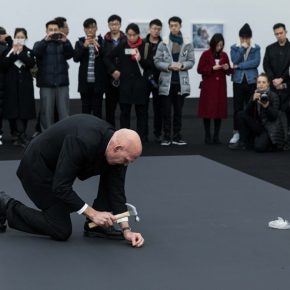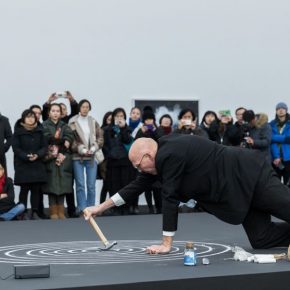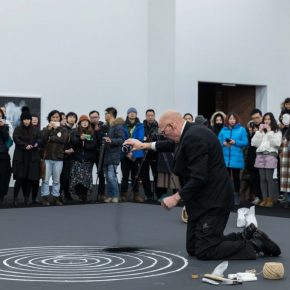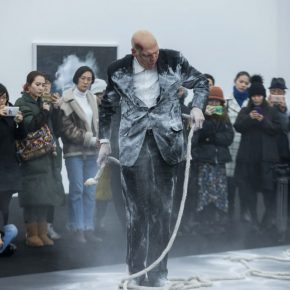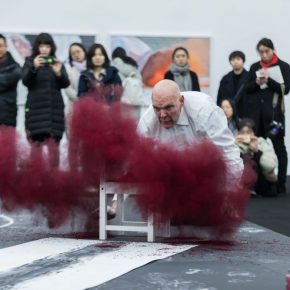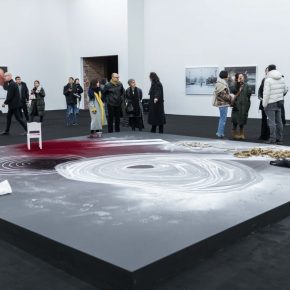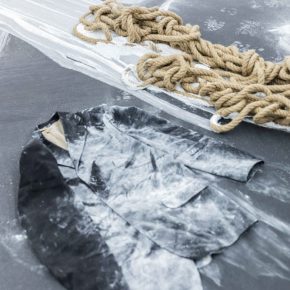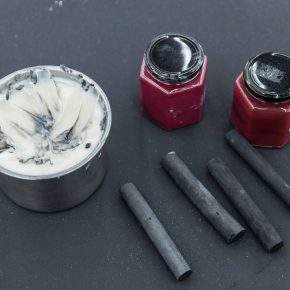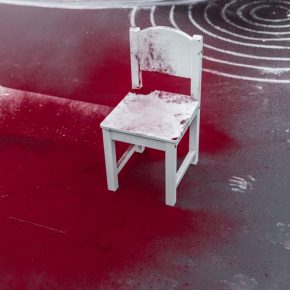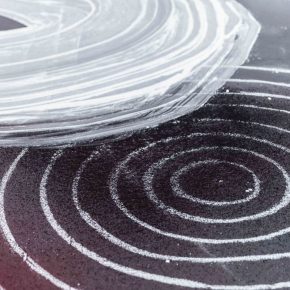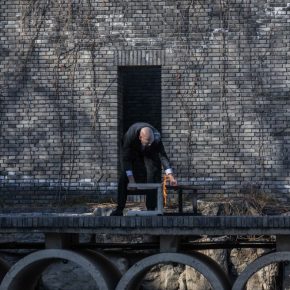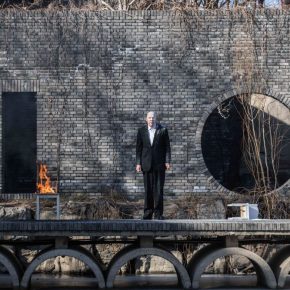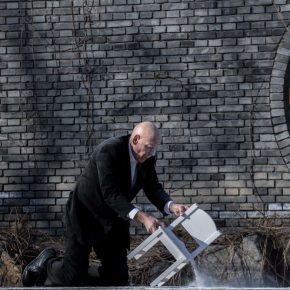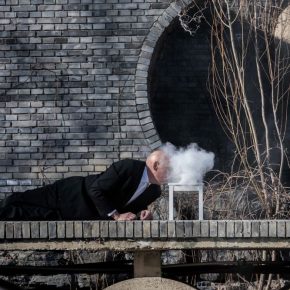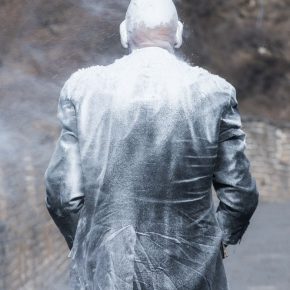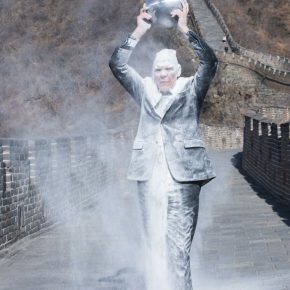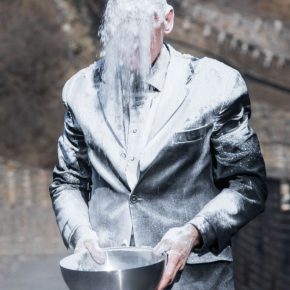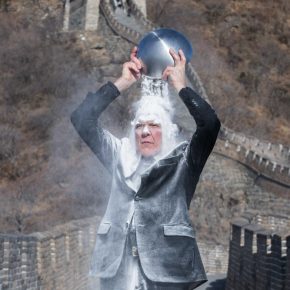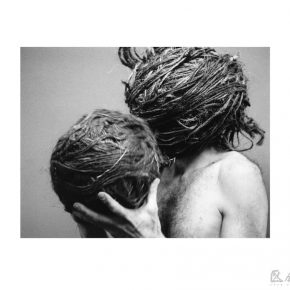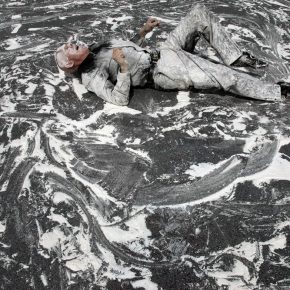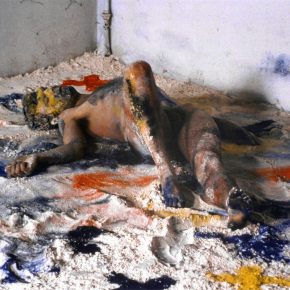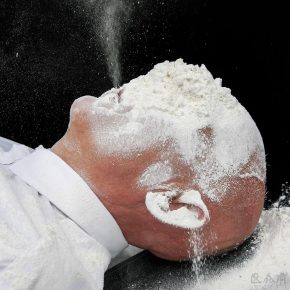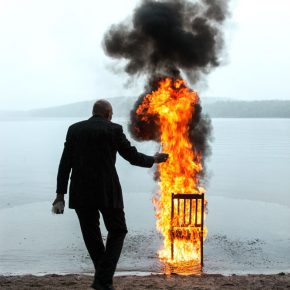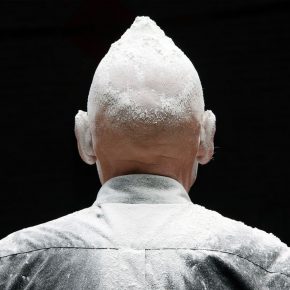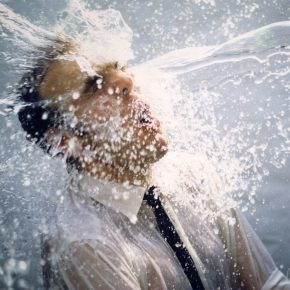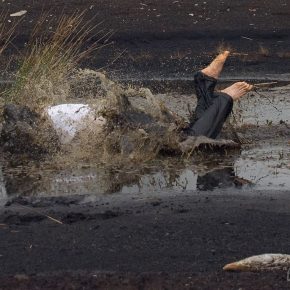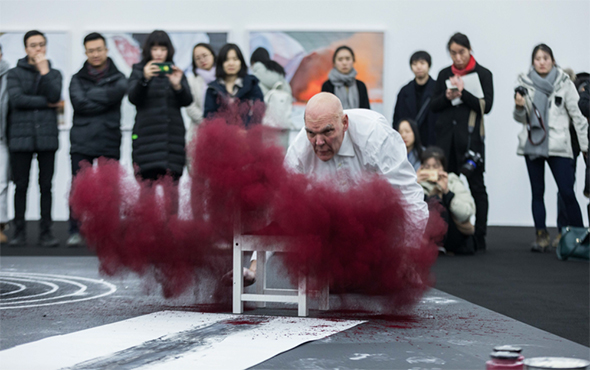
At 3:00 pm on January 31, 2018, the solo exhibition “The Time is Now” of the British artist Nigel Rolfe (b. 1950, Isle of Wight, UK), was held at the Red Brick Art Museum, and it was curated by senior curator Jonas Stampe of the Red Brick Art Museum. With a career that began in 1969, spanning five decades, Nigel Rolfe has been one of the most active and prominent practitioners of performance art. This exhibition reviews Rolfe’s artistic practice through his past work, site-specific photographs and pieces recently created at the museum. In addition to 20 photos of performance art, the exhibition also presents important video works by the artist.
From Sculpture in Motion to Performance Art: Art Context of Rolfe
In 1969, the 19-year-old Rolfe chose performance art that was younger than the artist. His first work is to put pieces of articles together, and this process was called “sculpture in motion”. As a practitioner that engaged early on in the exploration of performance art, Rolfe recalled in a conversation with curator Stampe, that there were only six spectators when he started performing in the beginning. When Rolfe went to New York for a performance ten years later, the majority of the audiences were artists. In Rolfe’s view, the performance art at that time was merely an art movement initiated by artists and consumed by artists. But it was this connection between the artists that encouraged Rolfe to further explore the creation of performance art. The trip to New York has impressed Rolfe, as David Hockney told him after watching the show: “Your performance art is the only piece that I can take home.”
As a performance artist originally engaged in sculptural creation, Rolfe cares about the “sense of touch”, touching all the materials that he is interested in by hand. In order to broaden the expression of works, Rolfe began to research and use the sound and image in the 1980s. Instead of using images to record, he used images to examine and test his biological and psychological limits and considered his body as a platform to challenge limits and expose the fragility of life. His works cover live performance, photography, image and sound. In recent years, Rolfe has been making large-scale creations of images, videos and sound based on the images of the practices of performance art, as well as on-site remnants and related research.
Performance art is a kind of artistic form that transcends physical limitations, and the body plays an important role in it. Nigel Rolfe’s work often uses the body as a tool of “sculptures in motion” and painting, to directly interact with or confront raw materials and environments such as water, fire, air, earth and wood, where it finds and builds a balanced dynamic visual process with violent riots and crashes, which are manifested on the body, such as his work of “Archive. Water In Face” (1980), “Into The Mire First Fall” (2010), “Chair At Waters Edge” (2015). He has always used the body as a place to challenge physical and psychological limits and reveal the vulnerability of life. In his 50-year practice in the field of performance art, with perseverance, endurance, honesty and passion, Rolfe together with Marina Abramovich and a few other artists has created a vocabulary during the period of the performance art that has entered the context of contemporary art context.
Creation of the Three Live Performances: The Current Presentation of Rolfe’s Performance Art
Nigel Rolfe presented three live performances in succession over three days during his first exhibition in China. On January 29, he chose to use thin white talcum powder, dumped on the head and then dying the artist and the black suit white and then creating the “Ghost of the Air – The Great Wall” at the Mutianyu Great Wall. In this case, the artist himself and the black clothes were transformed into white dust, meaning to imply a connection between life and death. It is an image of the air, and an image of being a ghost, that has been presented. As an ancient military fortification and a grand landmark in human civilization, the Great Wall has been a creative element in artists’ work and and a source of inspiration for performance art. Through his customary methods of analysis, Rolfe will engage in a dialogue with an array of cultural implications and symbolic meanings that the Great Wall has borne throughout history, but he will also address and question the way in which these cultural and symbolic elements have been used in the context of contemporary art.
In fact, for Rolfe, he is not interested in the powder but the reaction of such a thin medium floating in the air or around the body, so he looks for the necessary conditions for dust to float around before presenting a performance. Prior to the performance at the Great Wall, Rolfe stood at the entrance to a high beacon, repeatedly confronted or faced away from the wall, and then looked into the distance to experience the space and thus experience the existence of space. At the location, the powder, as a medium between the presence of solids and the fluid state presented in the air, flying in the air, presents the space between the artist and the world. This kind of existence is a feeling and a transformation of materialism for the artist.
Rolfe is an artist who pays close attention to the choice of materials. His choices are often very ordinary and very contemporary and they are used to construct symbolic meanings. The symbolic meaning of the chair is authority in history and at present, or the “symbol of privilege” called by Arthur C. Danto. Hemp, rope is the symbol of knowledge or the symbol binding things together. These ordinary materials have been given a whole new meaning in Rolfe’s work. On January 30, he presented a work of “Two Chairs – The Garden” in the garden of the Red Brick Art Museum, where the artist completed an experience of life, between a baby chair and an adult chair on a bridge across the icy lake, and a dialogue between the present and the future. Rolfe lying in front of a baby chair, with the most primitive act of mankind – breathing, intimately touching the white powder and igniting the adult chair. Fire, fog and ice, as the extension of the body and movement of the artist, have realized the interweaving of the movement and motionlessness in the quiet space of the Red Brick Art Museum with oriental aesthetics.
On the opening day, the artist performed “Dissonance” on the black platform in the exhibition hall. The performance started with music by Igor Fedorovitch Stravinsky, and used colored powder, chairs, ropes and a black suit that often appear in the works of the artist, and the dramatic tension was released into the interior space. Rolfe used the creation and destruction of three images to show the disharmony that mankind faces in many fields and on many levels, the multi-layered circles ruined by the black color, the irregular circles drawn with the hem ropes bounded with the body, and the scarlet powder submerging the chair, are intertwined at the edge of it which seems to throw up a struggle, wrestling, and traces of death and survival to the audience. As part of the exhibition, remnants of the scene of the performance are then presented to the audience.
We can’t understand an artist’s live performance art through our own experience. However, we are all present, which is the most important meaning of performance art: there is no barrier between the artist and people. The three performances switch between the ancient and modern space and time, in the field that carries Chinese tradition and contemporary cultural connotations, giving the Chinese audience a three-dimensional view of the artist’s creation and bringing the audience an unique experience of participation. It will be close on February 25.
Text by Yang Zhonghui, translated by Chen Peihua and edited by Sue/CAFA ART INFO
Photo courtesy of the organizer
About the Exhibition
Title: Nigel Rolfe: The Time is Now
Curator: Jonas Stampe
Venue: Red Brick Art Museum (No.1 International Art District, Hegezhuang,Northeast of Beijing)
Duration: February 1 – February 25, 2018


